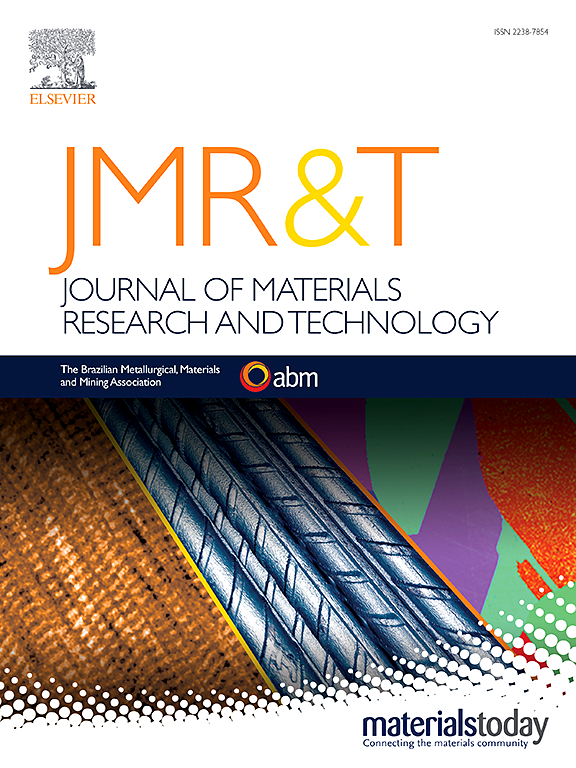NiAl含量对CoCrFeNi-NiAl-Nb伪三元三相亚共晶高熵合金组织和性能的影响
IF 6.2
2区 材料科学
Q1 MATERIALS SCIENCE, MULTIDISCIPLINARY
Journal of Materials Research and Technology-Jmr&t
Pub Date : 2025-06-04
DOI:10.1016/j.jmrt.2025.06.011
引用次数: 0
摘要
共晶高熵合金(EHEAs)因其均匀细腻的微观组织、优异的铸造性能和广泛的工业应用而备受关注。本实验制备了一系列三相亚共晶高熵合金(HEAs),命名为(CoCrFeNi)93-x(NiAl)xNb7(其中x = 8,12,16,19,22,26,32)。除NiAl-8合金外,其余成分均表现为FCC相、B2相和Laves相,其特征为拓扑密集排列的晶格结构(TCP)。随着NiAl含量的增加,合金的屈服强度从866.8±20 MPa增加到1459.8±16 MPa,伸长率从31.29±0.36%下降到16.83±0.16%。试验合金中,NiAl-16合金的屈服强度为961.4±12 MPa,断裂强度为2089.4±18 MPa,塑性应变为33.99±0.18%,具有良好的塑性。这些结果清楚地表明,这种合金具有巨大的工程应用潜力。基于三相亚共晶HEAs中韧性FCC相与脆性B2/Laves相的耦合,分析了该合金高强高塑性的内在机理。利用热力学参数对合金进行相预测表明,当条件6.7≤VEC <7.8, δ >;5%, ΔX >;达到7%。本文章由计算机程序翻译,如有差异,请以英文原文为准。
The effect of NiAl content on the microstructure and properties of CoCrFeNi–NiAl–Nb pseudo-ternary triple-phase hypoeutectic high-entropy alloys
Eutectic high-entropy alloys (EHEAs) have garnered significant attention due to their uniform and fine microstructure, exceptional casting properties, and broad range of industrial applications. A series of triple-phase hypoeutectic high-entropy alloys (HEAs), designated as (CoCrFeNi)93-x(NiAl)xNb7 (where x = 8, 12, 16, 19, 22, 26, 32), were developed in the present experiments. With the exception of the NiAl-8 alloy, all other compositions exhibited FCC, B2, and Laves phases, characterized by topologically densely arranged lattice structures (TCP). The yield strength of the alloy increased from 866.8 ± 20 MPa to 1459.8 ± 16 MPa, while the elongation decreased from 31.29 ± 0.36 % to 16.83 ± 0.16 % as the NiAl content increased. Among the alloys tested, the NiAl-16 alloy exhibited remarkable plasticity, with a yield strength of 961.4 ± 12 MPa, a fracture strength of 2089.4 ± 18 MPa, and a plastic strain of 33.99 ± 0.18 %. These results clearly indicate that this type of alloy has significant potential for engineering applications. Furthermore, based on the coupling of the ductile FCC phase and the brittle B2/Laves phase in the triple-phase hypoeutectic HEAs, the intrinsic mechanism of the high strength and high plasticity of the alloy is analyzed. The phase prediction of the alloy using thermodynamic parameters indicates that the triple phases—FCC phase, Laves phase, and B2 phase—can be stabilized when conditions 6.7 ≤ VEC <7.8, δ > 5 %, and ΔX > 7 % are met.
求助全文
通过发布文献求助,成功后即可免费获取论文全文。
去求助
来源期刊

Journal of Materials Research and Technology-Jmr&t
Materials Science-Metals and Alloys
CiteScore
8.80
自引率
9.40%
发文量
1877
审稿时长
35 days
期刊介绍:
The Journal of Materials Research and Technology is a publication of ABM - Brazilian Metallurgical, Materials and Mining Association - and publishes four issues per year also with a free version online (www.jmrt.com.br). The journal provides an international medium for the publication of theoretical and experimental studies related to Metallurgy, Materials and Minerals research and technology. Appropriate submissions to the Journal of Materials Research and Technology should include scientific and/or engineering factors which affect processes and products in the Metallurgy, Materials and Mining areas.
 求助内容:
求助内容: 应助结果提醒方式:
应助结果提醒方式:


